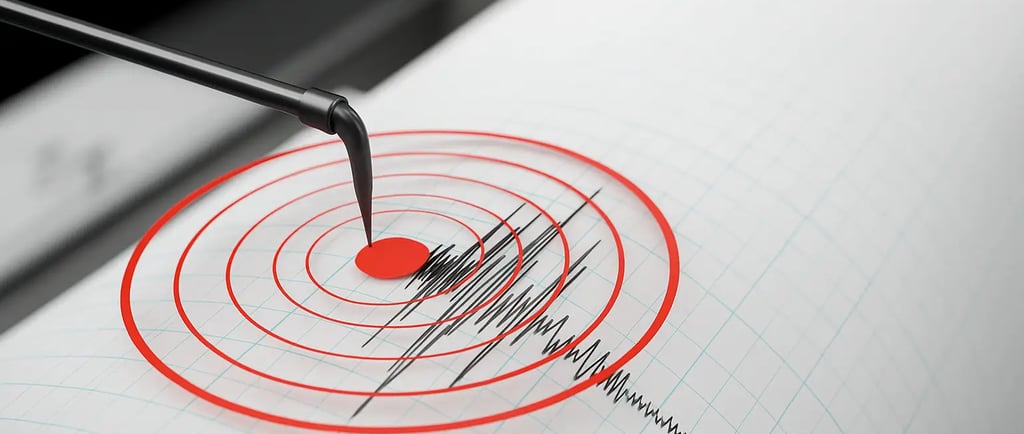Earthquake Seismograph Detects 8.8 Quake in Pacific
Earthquake seismograph captures powerful 8.8 quake near Kamchatka, triggering tsunami warnings across Hawaii, Japan, U.S. West Coast, and more.


Honolulu, Hawaii – July 31, 2025 – A powerful earthquake measuring 8.8 in magnitude struck off the coast of Russia's Far East, triggering widespread tsunami warnings, advisories, and watches across the Pacific Ocean. Countries including the United States, Japan, Chile, and China implemented emergency protocols. While tsunami waves reached multiple coastlines, including the Hawaiian Islands, the U.S. West Coast, and parts of South America.
The Pacific Tsunami Warning Center (PTWC) immediately issued official tsunami warnings for Hawaii, with alerts stating that waves over 5 feet were possible and could pose a serious risk to coastal areas. As a precaution, thousands were told to move to higher ground, especially in vulnerable zones such as Waikiki Beach, Hilo, and Kahului.
Emergency coastal notification Issued After Major Earthquake Off Kamchatka Peninsula:
The earthquake occurred at approximately 7:17 p.m. local time (HST) on Tuesday, with the U.S. Geological Survey (USGS) confirming its epicenter was about 74 miles southeast of Petropavlovsk-Kamchatsky, a city in the Kamchatka Peninsula. The tremor, described as a major earthquake, was felt widely and followed by several aftershocks reaching up to 6.9 in magnitude.
The National Tsunami Warning Center (NTWC) and the National Weather Service (NWS) immediately flagged this event as a destructive tsunami threat, launching alerts across the Ring of Fire. Several waves up to 13 feet above sea level were recorded in Kamchatka, and volcanic activity was reported from Klyuchevskaya Sopka, one of the most active volcanoes in the world.
Tsunami Warning and Advisory for Hawaii:
Following the quake, the Hawaiian Islands were placed under a tsunami warning, later downgraded to a tsunami advisory after observations showed wave heights between 4 to 6 feet. Emergency management teams across Oahu, the Big Island, and Maui opened shelters and issued evacuation orders for low-lying zones.
Hawaii Governor Josh Green confirmed that Black Hawk helicopters and high-water vehicles were on standby. Meanwhile, residents reported traffic jams and long lines at gas stations as they fled coastal areas. In Honolulu, tourists at the ‘Alohilani Resort were seen watching the surf from balconies as alerts continued late into the night.
By 10 p.m. local time, the Pacific Tsunami Warning Center noted that wave heights had peaked, and by Wednesday morning, officials gave the all-clear. Still, experts from the National Oceanic and Atmospheric Administration (NOAA) warned that strong currents could persist for hours due to the way seismic sea wave energy behaves.
“A tsunami is not just one wave,” said Dan Snider of the National Tsunami Warning Center. “They travel fast in deep water, like a jet, but slow and rise as they reach shorelines. The risk of widespread inundation is highest near shallow coasts.”
U.S. West Coast Under Tsunami Watch and Advisory:
Submarine wave watches and advisories were also issued for the U.S. West Coast, from Southern California to the Aleutian Islands in Alaska. The National Weather Service Bay Area confirmed wave activity reached Monterey around 12:48 a.m. PT, with waves also hitting San Francisco, Port San Luis, and Crescent City.
Crescent City, notorious for past damage, saw waves of approximately 3.5 feet, with concerns rising due to a minor high tide. The California Office of Emergency Services coordinated with local departments in Northern California and the California-Oregon border, while Governor Gavin Newsom urged residents to avoid beaches until further notice.
Wider Pacific Impact: International Tsunami Alerts
The massive quake sent tsunami alerts across the Pacific Basin:
Japan’s Meteorological Agency issued evacuation advisories for nearly 2 million residents across 220 coastal towns.
China’s Tsunami Warning Center predicted tsunami wave heights of 3 feet for Zhejiang Province, already bracing for Typhoon CoMay.
Chile, Ecuador, and Colombia activated the highest-level tsunami warnings, closing beaches and schools.
New Zealand’s emergency management urged citizens to avoid harbors due to “strong and unusual currents.”
In Mexico, tsunami waves were forecast to reach Ensenada and continue to Chiapas state by morning.
The Galapagos Islands canceled all coastal activities as a precaution.
In many of these areas, alerts came in the form of tsunami information statements, watches, or advisories, depending on the local threat level.
Tsunami Warning Categories Explained:
To help residents understand the risk levels, here’s a quick overview of tsunami alert types from the National Weather Service:
Marine threat advisory – Take immediate action; widespread flooding is expected.
Tsunami Advisory – Strong waves may cause danger to those near the water; stay out of the ocean.
Tsunami Watch – A tsunami is possible; remain alert and monitor updates.
Information Statement – An earthquake occurred, but no sudden sea swell threat is detected.
Volcanic Eruption Adds to Chaos in Kamchatka
Adding to the region's turmoil, Klyuchevskaya Sopka erupted within hours of the quake. Lava flows and ash clouds were recorded on the volcano’s western slopes. Experts from the Russian Academy of Sciences had been monitoring rising pressure in the crater for weeks. The eruption, though spectacular, posed no immediate threat beyond local disruptions.
Final Thoughts: Stay Prepared:
This massive 8.8 magnitude earthquake reminds us of the Pacific’s seismic volatility. Though the tsunami waves caused minimal destruction, the event highlighted the need for rapid response, public awareness, and robust emergency management systems.
For those living in watch areas, knowing evacuation routes and staying updated via the National Tsunami Warning Center, NOAA, and local emergency alerts is critical.
Insights
Stay updated with the latest tech and entertainment.
Explore
© 2025. All rights reserved.
Terms and Conditions
Privacy Policy
About us